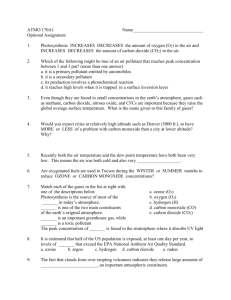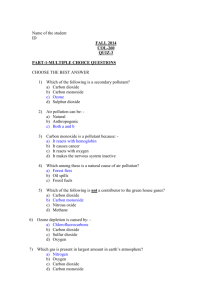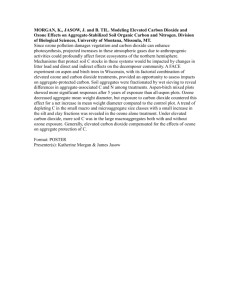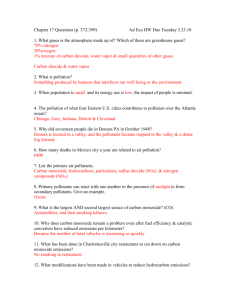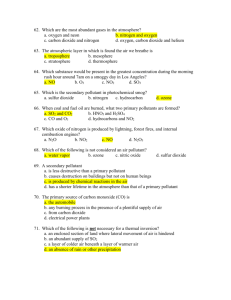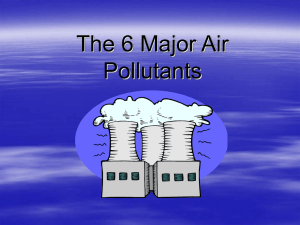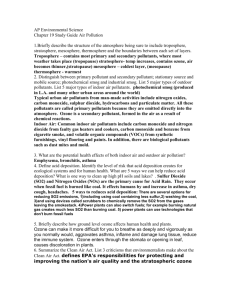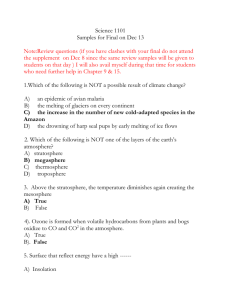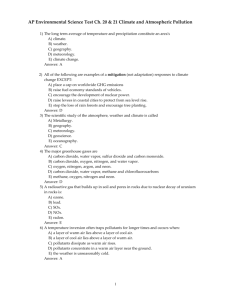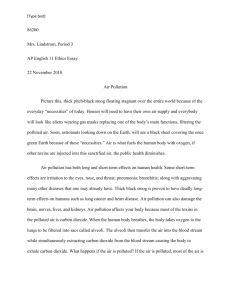Answers
advertisement
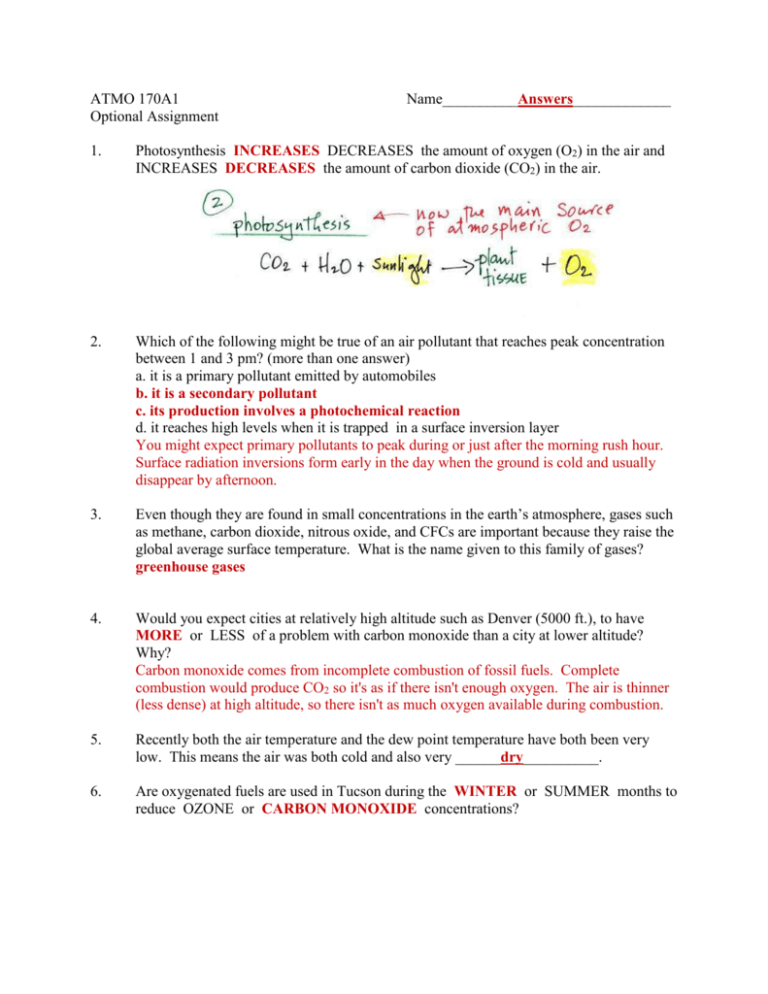
ATMO 170A1 Optional Assignment Name__________Answers_____________ 1. Photosynthesis INCREASES DECREASES the amount of oxygen (O2) in the air and INCREASES DECREASES the amount of carbon dioxide (CO2) in the air. 2. Which of the following might be true of an air pollutant that reaches peak concentration between 1 and 3 pm? (more than one answer) a. it is a primary pollutant emitted by automobiles b. it is a secondary pollutant c. its production involves a photochemical reaction d. it reaches high levels when it is trapped in a surface inversion layer You might expect primary pollutants to peak during or just after the morning rush hour. Surface radiation inversions form early in the day when the ground is cold and usually disappear by afternoon. 3. Even though they are found in small concentrations in the earth’s atmosphere, gases such as methane, carbon dioxide, nitrous oxide, and CFCs are important because they raise the global average surface temperature. What is the name given to this family of gases? greenhouse gases 4. Would you expect cities at relatively high altitude such as Denver (5000 ft.), to have MORE or LESS of a problem with carbon monoxide than a city at lower altitude? Why? Carbon monoxide comes from incomplete combustion of fossil fuels. Complete combustion would produce CO2 so it's as if there isn't enough oxygen. The air is thinner (less dense) at high altitude, so there isn't as much oxygen available during combustion. 5. Recently both the air temperature and the dew point temperature have both been very low. This means the air was both cold and also very ______dry__________. 6. Are oxygenated fuels are used in Tucson during the WINTER or SUMMER months to reduce OZONE or CARBON MONOXIDE concentrations? 7. Match each of the gases in the list at right with one of the descriptions below a. ozone (O3) Photosynthesis is the source of most of the b. oxygen (O2) ___b___ in today’s atmosphere. c. hydrogen (H) ___c___ is one of the two main constituents d. carbon monoxide (CO) of the earth’s original atmosphere. e. carbon dioxide (CO2) ___e___ is an important greenhouse gas, while ___d___ is a toxic pollutant The peak concentration of ___a___ is found in the stratosphere where it absorbs UV light 8. It is estimated that half of the US population is exposed, at least one day per year, to levels of _______ that exceed the EPA National Ambient Air Quality Standard. a. ozone b. argon c. hydrogen d. carbon dioxide e. radon 9. The fact that clouds form over erupting volcanoes indicates they release large amounts of ______water vapor___________, an important atmospheric constituent. 10. Which of the following explains why a surface inversion layer will concentrate air pollutants? a. high relative humidity b. stable atmospheric conditions c. high atmospheric pressure d. low air temperature 11. In a class demonstration, ___a___ gas was bubbled through Tucson tap water, lowering its pH and making it acidic. In the atmosphere _______ reacts in clouds to form acid rain a. carbon dioxide b. sulfur dioxide c. chlorine d. ozone e. nitrogen f. hydrogen 12. Would you expect to find the highest tropospheric ozone concentrations on a SUNNY or a CLOUDY day? The formation of ozone involves a photochemical reaction (sunlight is required). 13. Parts per million (ppm) are units of a. concentration b. weight c. volume d. pressure 14. If you wanted to make some ozone for a class demonstration you’d need a source of ultraviolet light and also some ____oxygen___________ Many people mentioned a lemon peel. If you put some lemon peel in a bottle containing ozone then you can make photochemical smog. But you need the ozone first and that requires oxygen. 15. Which of the following are considered greenhouse gases? (more than one answer) a. oxygen b. water vapor c. carbon dioxide d. carbon monoxide e. nitrogen f. sulfur dioxide 16. Volcanoes emit a lot of water vapor and carbon dioxide. They are also an important natural source of a. ozone b. sulfur dioxide c. argon d. carbon monoxide 17. Which one of the following doesn’t really belong in the same group as the other four? a. argon b. plants c. oxygen d. carbon dioxide e. photosynthesis 18. Photodissociation of water vapor and carbon dioxide is thought to have produced the first ________oxygen_________________ in the earth’s atmosphere. 19. Nitrogen (N2) and oxygen (O2) react in automobile engines and nitric oxide (NO) is emitted in the car’s exhaust. Nitric oxide is a PRIMARY SECONDARY pollutant. 20. The combustion (burning) of methane (natural gas) could be written in the form of a chemical equation as follows: CH4 + O2 product gases The product gases would likely be which two of the following? a. water vapor b. sulfur dioxide c. ozone d. carbon dioxide
